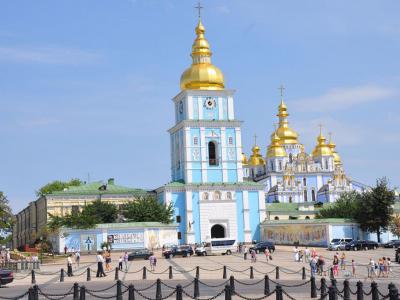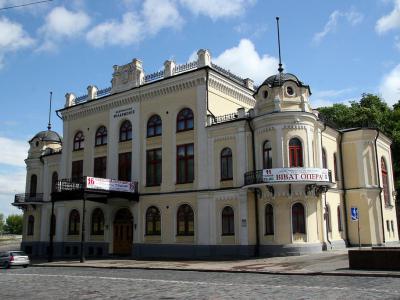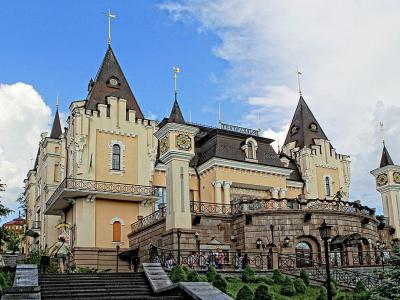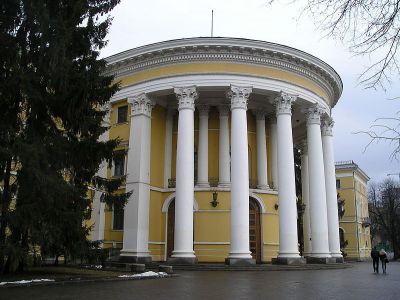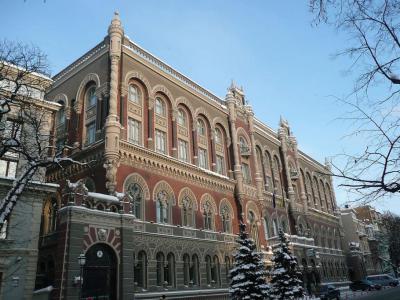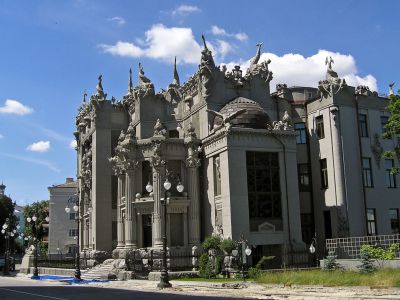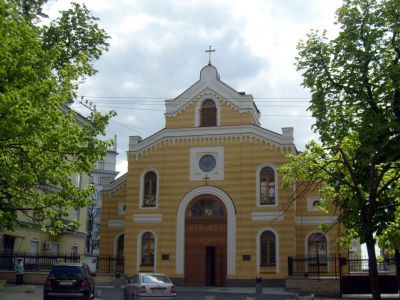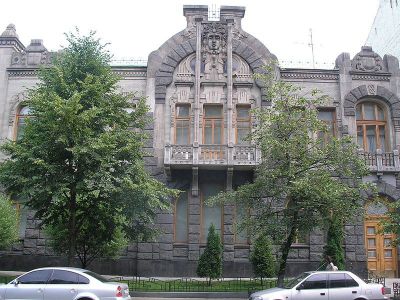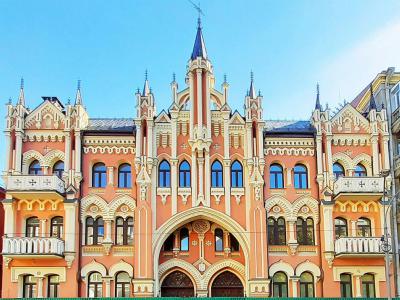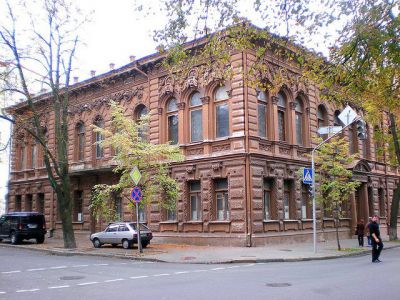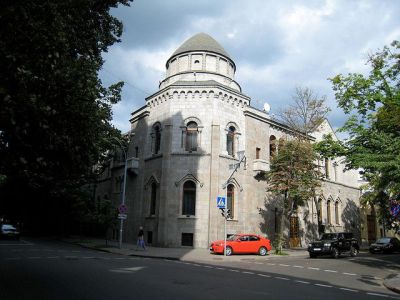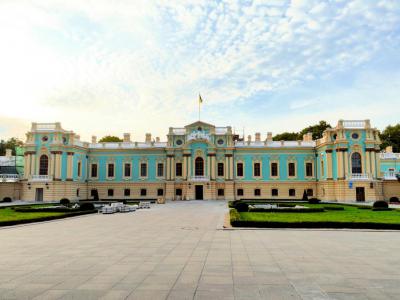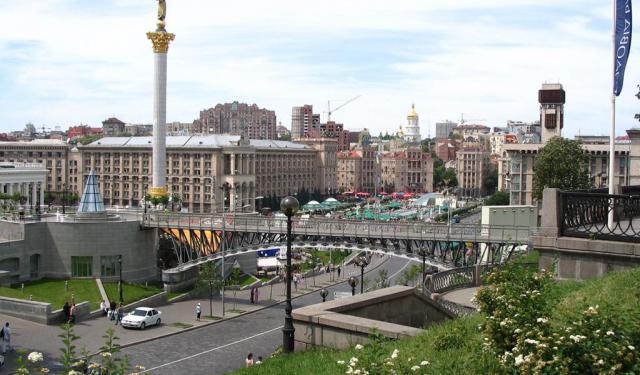
Kiev's Architectural Jewels (Self Guided), Kiev
Kiev is a city with such a wide diversity of architectural styles from various periods of time. The best European, Russian and Ukrainian architects and artists worked on the buildings of the capital of Ukraine. Some of the elements are absolutely unique and can be seen exclusively in Kiev. Some of the most famed architects who contributed to the city's beauty and originality are Vikentiy Beretti, Emilio Sala and other talented masters. The architecture tour is organized in the Lipki district.
How it works: Download the app "GPSmyCity: Walks in 1K+ Cities" from Apple App Store or Google Play Store to your mobile phone or tablet. The app turns your mobile device into a personal tour guide and its built-in GPS navigation functions guide you from one tour stop to next. The app works offline, so no data plan is needed when traveling abroad.
Kiev's Architectural Jewels Map
Guide Name: Kiev's Architectural Jewels
Guide Location: Ukraine » Kiev (See other walking tours in Kiev)
Guide Type: Self-guided Walking Tour (Sightseeing)
# of Attractions: 12
Tour Duration: 2 Hour(s)
Travel Distance: 4.1 Km or 2.5 Miles
Author: Cathy
Sight(s) Featured in This Guide:
Guide Location: Ukraine » Kiev (See other walking tours in Kiev)
Guide Type: Self-guided Walking Tour (Sightseeing)
# of Attractions: 12
Tour Duration: 2 Hour(s)
Travel Distance: 4.1 Km or 2.5 Miles
Author: Cathy
Sight(s) Featured in This Guide:
- Saint Michael's Golden-Domed Cathedral and Monastery
- National Philharmonic Society
- Kiev Academic Puppet Show Theatre
- October Palace
- National Bank of Ukraine
- The House With Chimeras
- Saint Catherine's German Lutheran Church
- House of Weeping Widow
- Tenement House (Dohodny Dom)
- The Chocolate House
- Kovalevsky House
- Mariinski Palace
1) Saint Michael's Golden-Domed Cathedral and Monastery (must see)
Saint Michael’s Golden-Domed Cathedral, one of the city's most impressive architectural monuments, has a rich and tumultuous history. Its foundation was laid in 1108, by the sons of Grand Duke of Kiev, Izyaslav Yaroslavovich. In 1113, the Byzantine style cathedral was inaugurated under the aegis of Demetrius’ Monastery. A series of Mongol attacks in the later centuries inflicted great damage upon the cathedral so that by the 15th century it was in much need of repair. In 1495, the cathedral was renamed Saint Michael's in homage to Archangel Michael, the spiritual patron of Kiev.
Over the course of 18th century restorations, the cathedral was enlarged and its exterior remade into Baroque style. Partially because of that and also due to the Soviet authorities' often unfavourable stance on Christianity, the cathedral was sentenced to demolition in 1934. The edifice was fully restored in 1990, based on the old images and partially relying of the preserved original foundation. The architecture and the interior decorations resemble the original. Some of the old cathedral's relics, such as paintings, mosaics, etc., have been restored or returned to the new building.
Other than the cathedral itself, Saint Michael’s Golden-Domed complex includes a number of religious sites, namely: the Economy Gate (built in 1790), the Bell Tower (1716-1719), and the Refectory of St. John the Divine (1713).
Over the course of 18th century restorations, the cathedral was enlarged and its exterior remade into Baroque style. Partially because of that and also due to the Soviet authorities' often unfavourable stance on Christianity, the cathedral was sentenced to demolition in 1934. The edifice was fully restored in 1990, based on the old images and partially relying of the preserved original foundation. The architecture and the interior decorations resemble the original. Some of the old cathedral's relics, such as paintings, mosaics, etc., have been restored or returned to the new building.
Other than the cathedral itself, Saint Michael’s Golden-Domed complex includes a number of religious sites, namely: the Economy Gate (built in 1790), the Bell Tower (1716-1719), and the Refectory of St. John the Divine (1713).
2) National Philharmonic Society
The National Philharmonic Society is located at Vladimirsky Spusk, no. 2, in the House of the Merchant Assembly. The seat of the Ukrainian Philharmonic is a splendid 19th century edifice that has survived two world wars and recently been declared a local architectural monument.
The history of the National Philharmonic starts in 1863, with the establishment of the Kiev branch of the Imperial Russian Music Society. This new type of entertainment was highly appreciated by the locals. The House of Merchant Assembly was built in 1881, in time when the local artistic community grew particularly anxious to have a designated place for classical music. By 1919, the venue had seen performances by such iconic figures of the Russian music as Rakhmaninov, Sobinov, Skryabin, Nezhdanova and Shalyapin. The key role in the development of the Philharmonic was played by Nikolay Vitalevich Lysenko, whereas the name of Alexander Mihaylovich Vinogradsky has left the biggest imprint in its history, as one of the best conductors who had ever worked there.
In 1919, the Philharmonic was shut down and in 1927 moved to Kharkov. In 1934, it returned to Kiev. For most of WWII it didn't operate and resumed work only in 1944, after the city was liberated from the Nazis. In 1996, following profound restoration works, the National Philharmonic Society building was re-opened to the public.
The history of the National Philharmonic starts in 1863, with the establishment of the Kiev branch of the Imperial Russian Music Society. This new type of entertainment was highly appreciated by the locals. The House of Merchant Assembly was built in 1881, in time when the local artistic community grew particularly anxious to have a designated place for classical music. By 1919, the venue had seen performances by such iconic figures of the Russian music as Rakhmaninov, Sobinov, Skryabin, Nezhdanova and Shalyapin. The key role in the development of the Philharmonic was played by Nikolay Vitalevich Lysenko, whereas the name of Alexander Mihaylovich Vinogradsky has left the biggest imprint in its history, as one of the best conductors who had ever worked there.
In 1919, the Philharmonic was shut down and in 1927 moved to Kharkov. In 1934, it returned to Kiev. For most of WWII it didn't operate and resumed work only in 1944, after the city was liberated from the Nazis. In 1996, following profound restoration works, the National Philharmonic Society building was re-opened to the public.
3) Kiev Academic Puppet Show Theatre
The Kiev Academic Puppet Show Theatre is the oldest of the two puppet theatres in Kiev. It was founded in 1927, stemming from the Young Spectator’s Theatre. In 1929, the puppet branch grew completely independent from its “parent” organisation and launched a solo programme.
Its first location was the former Rote Fane cinema. Then, from 1936 to 1955, the theatre occupied premises of the current House of Actor, after which it moved into the Choral Synagogue where remained until 1997. Following that, for eight years, the Academic Puppet Show Theatre had travelled from on place to another, searching for a suitable stage until, in 2005, a fairytale, castle-like venue was purposely built for it. Apart from a stage, inside this building is also a children café and an exhibition of puppets brought from all over the world.
The vast majority of the puppets employed in the theatre have been in service since its early days, back in the 1920s, and are undisputed favourites of the audience. There also have been new “cast members” added over the years, and the theatre's repertoire has changed significantly as well to attract adult audience.
Its first location was the former Rote Fane cinema. Then, from 1936 to 1955, the theatre occupied premises of the current House of Actor, after which it moved into the Choral Synagogue where remained until 1997. Following that, for eight years, the Academic Puppet Show Theatre had travelled from on place to another, searching for a suitable stage until, in 2005, a fairytale, castle-like venue was purposely built for it. Apart from a stage, inside this building is also a children café and an exhibition of puppets brought from all over the world.
The vast majority of the puppets employed in the theatre have been in service since its early days, back in the 1920s, and are undisputed favourites of the audience. There also have been new “cast members” added over the years, and the theatre's repertoire has changed significantly as well to attract adult audience.
4) October Palace
The October Palace is a concert hall and a place where cultural events are held regularly. The palace was built at the turn of the 20th century to a design by Vikentiy Beretti, and initially hosted Institut Blagorodnyh Devits (the Noble Maidens School). After the 1917 Revolution, the building was taken over by a new government and used as the headquarters of ChK (the secret service, forefather of the KGB). It was here, during the Bolshevik period, that as many as 120,000 people - mostly intellectuals: writers, scientists, priests, teachers and actors – were executed by a firing squad.
During World War II, the building suffered great damage. It then had to undergo thorough restoration which lasted seven years, from 1952 until 1959, but largely preserved the original architecture. After the restoration, the October Palace has been used as a concert hall. Not long ago, it had a movie theater wing added in order to have more space for entertainment events.
During World War II, the building suffered great damage. It then had to undergo thorough restoration which lasted seven years, from 1952 until 1959, but largely preserved the original architecture. After the restoration, the October Palace has been used as a concert hall. Not long ago, it had a movie theater wing added in order to have more space for entertainment events.
5) National Bank of Ukraine
The National Bank of Ukraine is the central financial institution of the country. Its main function is to uphold the national financial system by keeping Ukraine’s currency stable. The bank was founded in 1839, as a branch of the the State Commerce Bank (of the then Russian Empire) and, since 1992, has functioned as an independent financial institution.
The National Bank is located at Institutska Street, no. 9, inside the building architected by O. Kobolyev. The exterior was done by O. Verbitskyi; interior - by famous Italian architect, Emilo Sala, with elements of Italian Renaissance “palazzo”. Upon its completion in 1905, the building boasted all of the latest amenities of the day, including central heating, ventilation and electricity. In order to successfully accommodate the personnel and documentation transferred from Kharkiv, two more floors were added to the structure in 1933. Although no visitors are allowed inside the building, you are welcome to admire its façade from the outside, which is well worth seeing.
The National Bank is located at Institutska Street, no. 9, inside the building architected by O. Kobolyev. The exterior was done by O. Verbitskyi; interior - by famous Italian architect, Emilo Sala, with elements of Italian Renaissance “palazzo”. Upon its completion in 1905, the building boasted all of the latest amenities of the day, including central heating, ventilation and electricity. In order to successfully accommodate the personnel and documentation transferred from Kharkiv, two more floors were added to the structure in 1933. Although no visitors are allowed inside the building, you are welcome to admire its façade from the outside, which is well worth seeing.
6) The House With Chimeras
The House with Chimeras is probably one of the most spectacular architectural sights in Kiev. Sitting on top of a hill, on unstable ground, the house was meant to shock, intrigue and please the eye in a manner previously unseen in the city. Known as “Gaudi of Kiev”, architect Gorodetsky took on this challenging project as a one-of-a-kind opportunity to create something “out of the box”. In 1902 he delivered a plan that defied all the architectonic beliefs of the century.
Made of concrete, the building is clad with numerous wall decorations and statues, both inside and outside. The dolphins, sirens, frogs, elephants, rhinos and snakes, seen on the exterior, were created by Emilio Sala. Although the building's façade shows only three floors, from the back it reveals all the six. The interior carries a big-game animal theme, with the halls, staircases and parts of the rooms decorated with animal and vegetal motifs.
This impressive building served as a residence for the upper class families until 1921, when the Bolsheviks repossessed it. Since then and until 2002, the house had accommodated a regional health clinic. As of 2005 the building has been the seat of the Ukrainian president and the venue for formal events. It is rarely open to the public, but is easy to be admired from the outside pedestrian area.
Made of concrete, the building is clad with numerous wall decorations and statues, both inside and outside. The dolphins, sirens, frogs, elephants, rhinos and snakes, seen on the exterior, were created by Emilio Sala. Although the building's façade shows only three floors, from the back it reveals all the six. The interior carries a big-game animal theme, with the halls, staircases and parts of the rooms decorated with animal and vegetal motifs.
This impressive building served as a residence for the upper class families until 1921, when the Bolsheviks repossessed it. Since then and until 2002, the house had accommodated a regional health clinic. As of 2005 the building has been the seat of the Ukrainian president and the venue for formal events. It is rarely open to the public, but is easy to be admired from the outside pedestrian area.
7) Saint Catherine's German Lutheran Church
Saint Catherine's German Lutheran Church was erected in 1857, but was closed down in 1938. For for the next sixty years, it was being used for different purposes, from depot to museum. In 1998 the Church was finally returned to the German Lutheran congregation. Today, this is the largest German Lutheran Church in Ukraine. It can hold up to six hundred people.
8) House of Weeping Widow
The House of Weeping Widow is an Art Nouveau edifice, architected by Edward Petrovich Bradtmanu, built in 1907. Acknowledged as a masterpiece of local architecture, the house was commissioned by Serhiy Arshavsky, who resided here until the Bolshevik Revolution took place in 1917. In 1918 the house was nationalized and turned into a public office. In 1939 it hosted the headquarters of the Kiev military district.
After World War II, the building became the seat of the Ukrainian Soviet republican government. Since 1992 it has been used consecutively by two Ukrainian presidents as their official residence, and accommodated high-ranking foreign politicians, including U.S. State Secretaries Madeleine Albright and Condoleezza Rice, Presidents of Brazil and Lithuania. Prior to becoming the official presidential residence, the house was renovated and its interior remodelled.
On the outside, it has retained the original look, featuring large doors, grey granite, stucco decorations, artificial stone blocks and labradorite. The upper part of the façade displays a sculpted head of a woman, which gives the house its name – when it rains, the water, pouring down the woman’s cheeks, creates an illusion of a crying face.
After World War II, the building became the seat of the Ukrainian Soviet republican government. Since 1992 it has been used consecutively by two Ukrainian presidents as their official residence, and accommodated high-ranking foreign politicians, including U.S. State Secretaries Madeleine Albright and Condoleezza Rice, Presidents of Brazil and Lithuania. Prior to becoming the official presidential residence, the house was renovated and its interior remodelled.
On the outside, it has retained the original look, featuring large doors, grey granite, stucco decorations, artificial stone blocks and labradorite. The upper part of the façade displays a sculpted head of a woman, which gives the house its name – when it rains, the water, pouring down the woman’s cheeks, creates an illusion of a crying face.
9) Tenement House (Dohodny Dom)
The Dohodny Dom (Tenement House) was built in 1901, in Gothic style. The house was designed by engineer Nikolay Vishnevskiy. Its owner was Baron Volodymir Ikskul-Gildenband. The house was seriously damaged during WWII, but it was repaired subsequently and the layout was modified. Not long ago, the Dohodny Dom was renovated one more time and is even used in movie scenes.
10) The Chocolate House
The Chocolate House is an 18th century Venetian Renaissance style building, commissioned by Semen Semenovich Mogilevtsev. It was erected in the 1890s to a design by famous architect Vladimir Nikolayev. The exotic name derives from the exterior of dark brown colour which resembles chocolate.
Similarly to the House of Chimeras, the Chocolate House, initially (for over fifteen years), had served as a private residence (for the Mogilevtsevs), and thus allowed no access for the general public. During the Soviet period, the building hosted the Central Civil Registration Office and, in 1986 - the Children’s Picture Gallery.
The house’s history took a positive turn in 2009 when it was put under the jurisdiction of the Kiev Museum of Russian Art and subjected to restoration. Three of its rooms - The White, the Art Nouveau, and the New Russian Room - have already been finished and opened to the public; completion of the rest of the building is still in progress. The original wall paintings and wood inlays have been widely applied, wherever possible, to recreate the original interior. After the restoration is over, the building is set to host the Museum of Paintings, Private Collection Museum, and a picture gallery.
Similarly to the House of Chimeras, the Chocolate House, initially (for over fifteen years), had served as a private residence (for the Mogilevtsevs), and thus allowed no access for the general public. During the Soviet period, the building hosted the Central Civil Registration Office and, in 1986 - the Children’s Picture Gallery.
The house’s history took a positive turn in 2009 when it was put under the jurisdiction of the Kiev Museum of Russian Art and subjected to restoration. Three of its rooms - The White, the Art Nouveau, and the New Russian Room - have already been finished and opened to the public; completion of the rest of the building is still in progress. The original wall paintings and wood inlays have been widely applied, wherever possible, to recreate the original interior. After the restoration is over, the building is set to host the Museum of Paintings, Private Collection Museum, and a picture gallery.
11) Kovalevsky House
The Kovalevsky house was inaugurated in 1911. It was developed by architect Pavel Alyoshin, upon official Nikolay Kovalevskiy's request. The house is designed in Roman style and resembles a Medieval castle. It is also called the Armenian house, due to its ingenious design. Notwithstanding the year it was built, the house is even equipped with a lift. A special room in this building is the train compartment room, designed after the place where Kovalevsky met his wife.
12) Mariinski Palace (must see)
The Mariinsky Palace in Kiev was built between 1750 and 1755 to a design by one of the most popular Italian architects working in Russia at the time, Bartolomeo Rastrelli. Meant as a private residence for Empress Elizabeth, the palace was sited on a hilly bank of the Dnieper river, near the present Verkhovna Rada (Ukraine's Parliament). The Baroque style complex has a symmetrical composition, with a two story main building facing Mariinsky Park and two single story buildings on each of the sides. Combined, the buildings form a court which encloses a beautiful park. On the inside the buildings are decorated in a Baroque style with a touch of Renaissance.
The palace was used as a royal residence for the first and only time in 1787, during the visit by Empress Catherine II to Kiev. In the years afterwards it accommodated mostly the city's governor-generals. In the 1870s, the Mariinsky suffered severe damage from a violent fire, that ravaged nearly all of it, and demanded serious restoration. Major restoration works also took place in the late 1940s following World War Two, and the early 1980s. All the works were performed in a strict accordance with the building’s original layout and fully retained the original colours, style and decorations.
Today, the palace is used as the residence of the Ukrainian president and hosts official meetings and receptions regularly attended by foreign leaders.
The palace was used as a royal residence for the first and only time in 1787, during the visit by Empress Catherine II to Kiev. In the years afterwards it accommodated mostly the city's governor-generals. In the 1870s, the Mariinsky suffered severe damage from a violent fire, that ravaged nearly all of it, and demanded serious restoration. Major restoration works also took place in the late 1940s following World War Two, and the early 1980s. All the works were performed in a strict accordance with the building’s original layout and fully retained the original colours, style and decorations.
Today, the palace is used as the residence of the Ukrainian president and hosts official meetings and receptions regularly attended by foreign leaders.
Walking Tours in Kiev, Ukraine
Create Your Own Walk in Kiev
Creating your own self-guided walk in Kiev is easy and fun. Choose the city attractions that you want to see and a walk route map will be created just for you. You can even set your hotel as the start point of the walk.
Andriyivskyy Descent Walk
Andriyivskyy (Andrew's) Descent is a historic cobblestone street, running 720 meters (2,360 ft) downhill from the Upper (Old) Town of Kiev to the once commercial neighborhood of Podil (Lower Town), ending at Kontraktova Square.
According to a legend, there was once a sea where the Dnieper River now flows. When Saint Andrew, the Apostle came to Kiev and erected a cross on the spot where St... view more
Tour Duration: 1 Hour(s)
Travel Distance: 0.6 Km or 0.4 Miles
According to a legend, there was once a sea where the Dnieper River now flows. When Saint Andrew, the Apostle came to Kiev and erected a cross on the spot where St... view more
Tour Duration: 1 Hour(s)
Travel Distance: 0.6 Km or 0.4 Miles
Monastery of Kiev Caves Tour
Some sources say that Kievo-Pecherskaya Lavra (Monastery of Kiev Caves Tour) was initiated in 1051, when Reverend Anthony arrived there. He, together with some of his followers, built an entire complex composed of caves and monasteries. When the monks moved to a monastery which is on Lavra's territory, the caves were utilized as burial sites. Nowadays it is included in the UNESCO World... view more
Tour Duration: 1 Hour(s)
Travel Distance: 1.5 Km or 0.9 Miles
Tour Duration: 1 Hour(s)
Travel Distance: 1.5 Km or 0.9 Miles
Kiev Introduction Walking Tour
Kiev is a very old city. It was initiated approximately 1500 years ago. Since 1934, it was Soviet Ukraine's capital and remained the main city of the country with the collapse of the Soviet Union. Being one of the biggest cities in Europe, it has a very specific history, architecture and cultural life. One can never be bored in Kiev, as it has endless interesting and captivating places to... view more
Tour Duration: 2 Hour(s)
Travel Distance: 3.6 Km or 2.2 Miles
Tour Duration: 2 Hour(s)
Travel Distance: 3.6 Km or 2.2 Miles
Useful Travel Guides for Planning Your Trip
Kiev Souvenirs: 12 Distinctively Ukrainian Products to Bring Home
In recent years, Ukraine has made the news rather distant from welcoming tourism. Still, despite some controversial publicity, the country - for the most part - continues normal life and retains its traditional hospitality. There are quite a few things in Kiev, distinctively Ukrainian, that a...
The Most Popular Cities
/ view all
